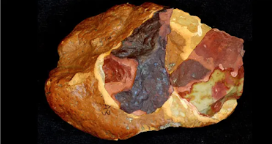In this recent week of class, we discussed early human techniques and their evolution in constructing various stone tools. We reviewed the types of percussion and hammering, and the four innovations in stone knapping: The Oldowan, Acheulian, Levallois, and Blade Technology techniques. These methods occurred alongside cognitive development in early humans. For instance, spatial awareness allowed for precise strikes and removal of flakes from a core stone. Goal-setting enabled the visualization of a final tool and a method to complete that end. Early humans exhibited significant creativity in devising stone tool techniques. Hence, it is hard to believe that the archaeological record was limited to four construction techniques. Early human ingenuity must have resulted in other methods of tool manufacturing.
Upon investigation, I discovered that ancient craftsmen employed heat treatment to temper their tools. Archaeological research from South Africa dates the earliest use of heat treatment to 45,000-70,000 years ago… stone tools were heated to roughly 600 degrees and likely buried under fire to make the stone easier to shape (Fountain). After heat treatment, less force was needed to flake a core. Percussion could be done with greater control and precision. Experimental archaeology was applied to validate these claims of heat treatment. Archaeologists matched the color of uncovered silcrete blades on the South African Coast by heating and flaking silcrete themselves (Fountain).

A silcrete nodule showing experimental changes in texture and color resulting from exposure to heat.
Photo Credit: Science/AAAS
Heat treatment was a prevalent practice. According to Mary Louise Kelly from All Things Considered on NPR, “Scientists say it [heat treatment] may have actually happened much earlier – 300,000 years ago. That’s based on a study of rock shards in the Middle East.” Further, “heat treatment first occurred in Europe about 25,000 years ago” (Fountain). Evidently, heat treatment was integral to the survival of different early human communities; it was an intercontinental and enduring innovation.
The adoption of heat treatment also transpired with growth in the cognition of early humans. Several skills were developed to produce tempered crafts. Sophisticated, controlled use of fire building was one adaptation (Early Humans Used). An understanding of careful planning and multi-tasking was another adaptation, as explained by Wadley and Prinsloo, “the making of compound adhesives involve[d] not only careful planning, but also multi-tasking…The artisan need[ed] to simultaneously mix ingredients, control fire temperature, and mentally rotate stone tools to create the desired composite product.” The archaeological record dispels ignorant notions of early humans being primitive. In actuality, they exhibited cognitive complexity and adeptly utilized their resources for survival.
The photo shows heated artifacts in silcrete made by Homo sapiens at Klipdrift Shelter, South Africa. Photo: Katja Douze, University of the Witwatersrand
Photo Credit: (Humans Used Fire)
Several other early human misconceptions are challenged by the discovery of heat treatment. First, early humans did not manufacture stone tools through only knapping and flaking. Second, fire was not only used for protection, cooking, and warmth. Third and lastly, heat treatment existed long before archaeologists’ first discovery of it in Europe, which was dated to 25,000 years ago (Fountain). Ultimately, heat treatment exemplifies transformative, early human adaptability and has clarified contemporary misperceptions of their capabilities.
Reference List
“Early Humans Used Innovative Heating Techniques to Make Stone Blades.” ScienceDaily,
October 20, 2016. https://www.sciencedaily.com/releases/2016/10/161020092107.htm.
Fountain, Henry. “Early Humans Used Heat to Shape Their Tools.” The New York Times, August
13, 2009. https://www.nytimes.com/2009/08/18/science/18obfire.html.
“Humans Used Fire Earlier than Previously Known.” University of Bergen. Accessed October 1,
2023. https://www.uib.no/en/news/101760/humans-used-fire-earlier-previously-known.
“Scientists Find Proof Early Humans Could Control Fire Temperature in Tempering Tools.” NPR,
October 6, 2020. https://www.npr.org/2020/10/06/920859196/scientists-find-proof-early-humans-could-control-fire-temperature-in-tempering-tv.
Wadley, L., Prinsloo, C. Linda. “Experimental Heat Treatment of Silcrete Implies Analogical
Reasoning in the Middle Stone Age.” Journal of Human Evolution, April 5, 2014. https://www.sciencedirect.com/science/article/pii/S0047248414000621#:~:text=Heat%20treatment%20of%20rocks%20is,an%20attribute%20of%20complex%20cognition.
Additional Readings:
Delagnes, Anne, Patrick Schmidt, Katja Douze, Sarah Wurz, Ludovic Bellot-Gurlet, Nicholas J
Conard, Klaus G Nickel, Karen L van Niekerk, and Christopher S Henshilwood. “Early Evidence for the Extensive Heat Treatment of Silcrete in the Howiesons Poort at Klipdrift Shelter (Layer PBD, 65 Ka), South Africa.” PloS one, October 19, 2016. https://www.ncbi.nlm.nih.gov/pmc/articles/PMC5070848/.
Stolarczyk, Regine E, and Patrick Schmidt. “Is Early Silcrete Heat Treatment a New Behavioural
Proxy in the Middle Stone Age?” PloS one, October 1, 2018. https://www.ncbi.nlm.nih.gov/pmc/articles/PMC6166942/.

You suggest that ancient craftsmen “exhibited cognitive complexity and adeptly utilized their resources for survival.” Why is this a valuable piece of knowledge for us to keep in mind? How would this argument aid modern-day explorations in other archaeological subfields or projects?
This piece of knowledge is valuable because it underscores the ingenuity of ancient craftsmen. In turn, ignorant stereotypes of our early ancestors being “unintelligent” or “unskilled” are dismantled. My argument also aids in modern day explorations in other archaeological subfields. Understanding that certain aspects of stone tools – their points of percussion, bulb of percussion, platform, etc – are intentional and not random, can help to contextualize these finds. Certain marks on stone tools can denote the work of particular civilizations or time periods. Through this contextualization, the migration of technology, ideas, and civilizations can become apparent.